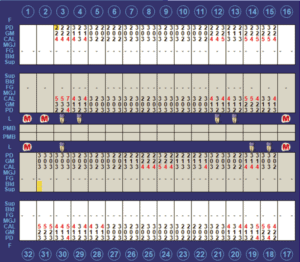Part 1: What are all those numbers my Hygienist calls out?

Part 1: What are all those numbers my Hygienist calls out?
During your dental cleaning (prophylaxis) appointment, you will hear your hygienist calling out a series of 6 numbers per tooth. These measurements are usually done yearly. What she is doing is measuring, in millimeters (mm), the depth of the cuff of gum tissue around each tooth. This depth is the difference in height between the level of your gumline and the point at which the gum actually attaches to your tooth. 2-3 mm is considered healthy and anything over 5 mm usually indicates that the bone that supports your tooth has begun to be destroyed by disease. Here is a little more detail on what measuring the “pockets” mean:
- 0 to 3 mm without bleeding: Congratulations! No issues!
- 1 to 3 mm with bleeding: This is mild gingivitis which is the mildest form of gum disease. Usually a good prophylaxis with therapeutic scaling coupled with effective oral home-care is all that is recommended.
- 4 to 5 mm without bleeding: The periodontal disease process is being maintained. Four visits per year with effective home-care is the recommended treatment.
- 4 to 5 mm with bleeding:Early to moderate gum disease (Periodontitis) which may require periodontal therapy over several visits as well as effective home care and four visits per year.
- 6mm and above: Advanced periodontal disease which means aggressive treatment to save your teeth. Periodontal Therapy appointments over several visits is the recommended treatment. Additionally, referral to a periodontist and surgery is almost always required to repair the damage done.Periodontal disease is not curable, therefore maintenance visits are recommended every 3 months thereafter, alternating with the Periodontist.
As noted, the presence of bleeding or pus when your periodontal numbers are being charted is a strong indicator of disease. Healthy gums do not bleed! The presence of gum disease leads to tooth loss and a greatly diminished quality of life. Gum disease is also implicated in serious health issues such as heart disease and strokes, diabetes, and respiratory problems. So, don’t put off you dental prophylaxis and checkups! The earlier these problems are detected, the easier and more predictable the treatment is.
We will discuss the second set of numbers, which reflect gum recession, in an upcoming blog.



